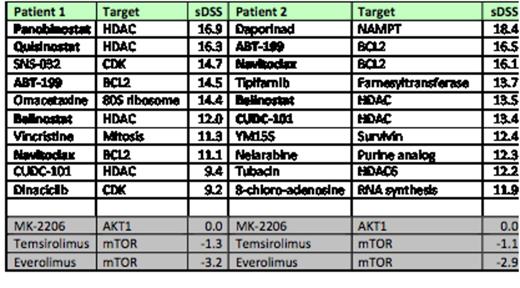Abstract
T-PLL is a rare mature post-thymic T-cell neoplasm with an aggressive clinical course and median overall survival of less than one year. Almost 75% of T-PLL cases harbor chromosome 14 translocations involving the T-cell receptor A/D locus resulting in aberrant activation of the proto-oncogenes TCL1A or MTCP1. T-PLL patients are difficult to treat as the leukemic cells are often resistant to most available chemotherapeutic drugs. Due to the rareness and aggressive nature of the disease, large clinical trials are difficult to execute. We therefore aimed to discover novel potential therapeutic targets using a high-throughput ex vivo drug sensitivity and resistance testing (DSRT) platform covering 306 approved and investigational oncology drugs.
Primary T-PLL cells were available from two patients. The first patient had a double positive CD4+CD8+CD3+ Vβ.14+ T-cell phenotype (patient 1) and cells underwent DSRT twice during a 5-month time-period (no treatment during that time). The second patient had a CD4+CD3+ phenotype (patient 2) and the cells were assayed once by DSRT. Fresh blood mononuclear cells (MNCs) were separated by Ficoll centrifugation from the patient samples (over 85 % leukemic cells in the MNC fraction) and healthy controls. Cells were seeded in 384-well plates and 306 active substances were tested using a 10,000-fold concentration range resulting in a dose-response curve for each compound. Cell viability was measured after 72 h incubation and differential drug sensitivity scores (DSS), representing leukemia-specific responses, were calculated by comparing patient samples with those obtained from healthy donors. In addition, both exome and RNA sequencing was performed from T-PLL cells (patient 1).
Both patient samples showed high sensitivity to small molecule BCL2-inhibitors navitoclax (EC50 values 44nM and 10nM) and ABT-199 (EC50 23nM and 20nM) (Fig. 1 and 2). HDAC-inhibitors (quisinostat, belinostat and panobinostat) also showed high sensitivity in both patients in low nM concentrations (EC50 values 1-80nM). As AKT1/mTOR pathway is activated in most T-PLL patients due to the TCL1 oncoprotein, it was interesting to observe that neither of the patient samples showed any response to an AKT1 inhibitor (MK-2206 EC50 values >1000 nM) nor to mTOR inhibitors (temsirolimus and everolimus)(Fig. 1). Furthermore, T-PLL cells were resistant to corticosteroids such as prednisolone and methylprednisolone.
The 10 most sensitive drugs for PLL patients, based on sDSS scores (comparison with two healthy controls). The last 3 rows represent sDSS scores for AKT1 and mTOR inhibitors.
The 10 most sensitive drugs for PLL patients, based on sDSS scores (comparison with two healthy controls). The last 3 rows represent sDSS scores for AKT1 and mTOR inhibitors.
DSS curves of BCL-2 inhibitors included in the DSRT of PLL patient 1 and healthy control.
DSS curves of BCL-2 inhibitors included in the DSRT of PLL patient 1 and healthy control.
To further elucidate the molecular mechanism behind the drug responses, exome and RNA sequencing was performed from T-PLL cells (patient 1). No deletion was found in the ATM gene, but instead a homozygous missense mutation K2413Q was detected. This particular mutation is in the region coding for the FAT domain and while it has not been described earlier in T-PLL, it is in a cancer mutation hotspot region of ATM, suggesting that it is inactivating. No mutations directly linked to the BCL2-family genes were observed. In the RNA sequencing analysis, TCL1A was overexpressed when compared to the healthy CD4+ cells as expected. Similarly, AKT1 was overexpressed. The expression of BCL-2 and BCL-XL did not differ from those observed in healthy CD4+ cells while pro-apoptotic BCL-2 family members BID and BAD were elevated compared to the healthy control.
Primary T-PLL cells showed sensitivity to BCL-2 and HDAC inhibitors in a systematic high-throughput ex vivo drug sensitivity testing across a range of clinical and investigational drugs. The BCL-2 inhibitor sensitivity was not related to increased BCL-2 expression or activating mutations in the BCL-2 family genes, and further studies are needed to clarify the mechanism of action. However, the results suggest that BCL-2 inhibitors could be a novel promising candidate drug for T-PLL-patients and warrant further clinical development in this group of patients. In contrast, inhibitors of AKT and mTOR, kinases known to be activated by TCL1, showed no efficacy ex vivo in this assay.
Porkka:BMS: Consultancy, Research Funding, Speakers Bureau; Novartis: Consultancy, Research Funding, Speakers Bureau. Mustjoki:Novartis: Consultancy, Speakers Bureau; BMS: Consultancy, Speakers Bureau.
Author notes
Asterisk with author names denotes non-ASH members.



This feature is available to Subscribers Only
Sign In or Create an Account Close Modal